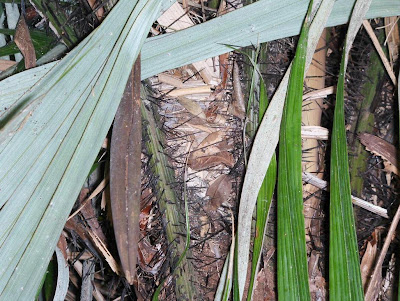 I may have to make a public apology to those big black birds, called greater anis. In a series of blog posts I accused them of parasitism, thinking that they were laying their eggs in a nest of another bird. I made this accusation, first of all because we found three of their eggs on the ground under a mumbaca palm. The rationale was that the real owner of the nest was rejecting them. Secondly, Cleuson told me that the anis were around much of the time, but that he had never seen them bringing in food or nest-building material. Well, I shouldn't jump to conclusions so fast. Yesterday I spotted two of the anis, I assume a couple, land in the jacarandá do Pará tree next to the palm. To my surprise one of the beautiful birds had what appeared to be food in her beak. They then flew into the palm, shown in the attached image. I may have found the nest. It appears to be where we see all those dried up leaves. In searching the web for pictures of the great ani, I found an article, which states that although a member of the cuckoo family, anis are not brood parasites. So, there you have it! Click on the link above to see pictures of our humiliated friends.
I may have to make a public apology to those big black birds, called greater anis. In a series of blog posts I accused them of parasitism, thinking that they were laying their eggs in a nest of another bird. I made this accusation, first of all because we found three of their eggs on the ground under a mumbaca palm. The rationale was that the real owner of the nest was rejecting them. Secondly, Cleuson told me that the anis were around much of the time, but that he had never seen them bringing in food or nest-building material. Well, I shouldn't jump to conclusions so fast. Yesterday I spotted two of the anis, I assume a couple, land in the jacarandá do Pará tree next to the palm. To my surprise one of the beautiful birds had what appeared to be food in her beak. They then flew into the palm, shown in the attached image. I may have found the nest. It appears to be where we see all those dried up leaves. In searching the web for pictures of the great ani, I found an article, which states that although a member of the cuckoo family, anis are not brood parasites. So, there you have it! Click on the link above to see pictures of our humiliated friends.
Friday, September 12, 2008
Ani eggs, continued
 I may have to make a public apology to those big black birds, called greater anis. In a series of blog posts I accused them of parasitism, thinking that they were laying their eggs in a nest of another bird. I made this accusation, first of all because we found three of their eggs on the ground under a mumbaca palm. The rationale was that the real owner of the nest was rejecting them. Secondly, Cleuson told me that the anis were around much of the time, but that he had never seen them bringing in food or nest-building material. Well, I shouldn't jump to conclusions so fast. Yesterday I spotted two of the anis, I assume a couple, land in the jacarandá do Pará tree next to the palm. To my surprise one of the beautiful birds had what appeared to be food in her beak. They then flew into the palm, shown in the attached image. I may have found the nest. It appears to be where we see all those dried up leaves. In searching the web for pictures of the great ani, I found an article, which states that although a member of the cuckoo family, anis are not brood parasites. So, there you have it! Click on the link above to see pictures of our humiliated friends.
I may have to make a public apology to those big black birds, called greater anis. In a series of blog posts I accused them of parasitism, thinking that they were laying their eggs in a nest of another bird. I made this accusation, first of all because we found three of their eggs on the ground under a mumbaca palm. The rationale was that the real owner of the nest was rejecting them. Secondly, Cleuson told me that the anis were around much of the time, but that he had never seen them bringing in food or nest-building material. Well, I shouldn't jump to conclusions so fast. Yesterday I spotted two of the anis, I assume a couple, land in the jacarandá do Pará tree next to the palm. To my surprise one of the beautiful birds had what appeared to be food in her beak. They then flew into the palm, shown in the attached image. I may have found the nest. It appears to be where we see all those dried up leaves. In searching the web for pictures of the great ani, I found an article, which states that although a member of the cuckoo family, anis are not brood parasites. So, there you have it! Click on the link above to see pictures of our humiliated friends.
Subscribe to:
Post Comments (Atom)
2 comments:
Greater ani doesn't reach the U.S., but I've been fortunate to see the groove-billed ani during its summer residence in the lower Rio Grande Valley. Its cousin the roadrunner is abundant there.
I haven't yet seen the smooth-billed ani, which gets up into southern Florida.
And you thought I only knew bugs ;-)
regards -- ted
> Ted, we see the groove-billed ani more on terra firme and the greater ani more on the floodplain. Don't know why we're seeing so many of the latter at the Bosque. Flashy birds. Cheers.
Post a Comment